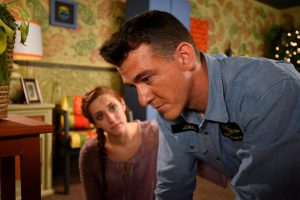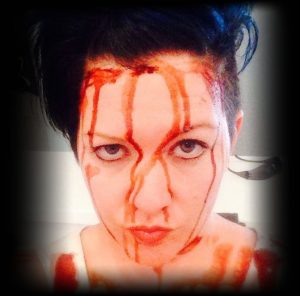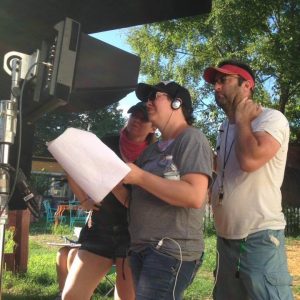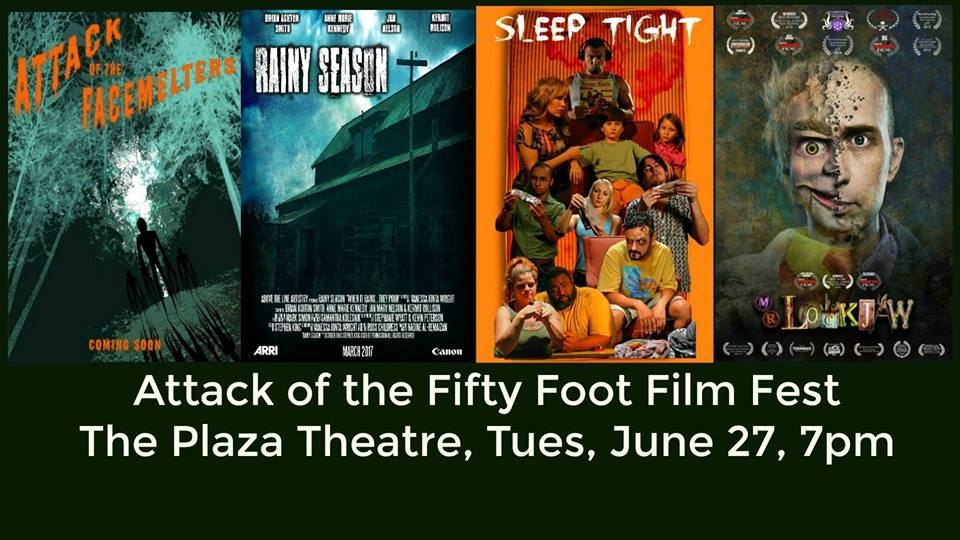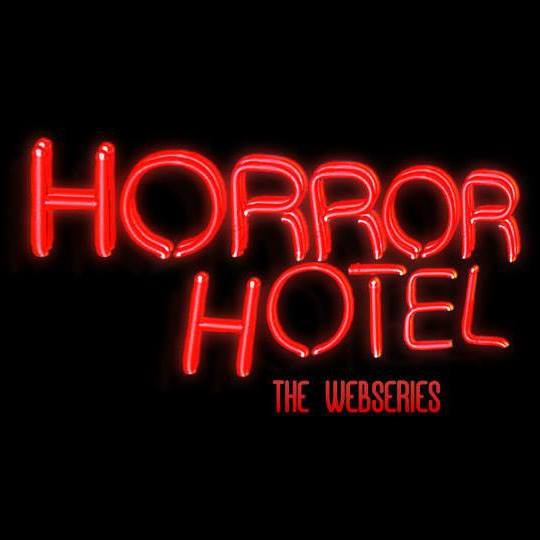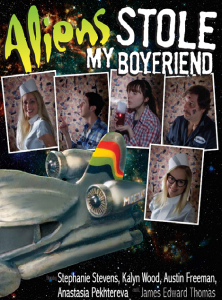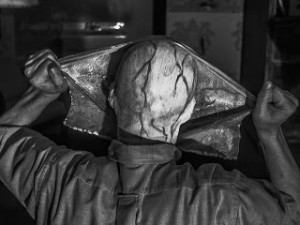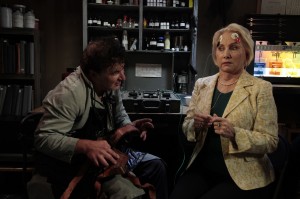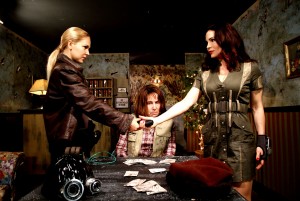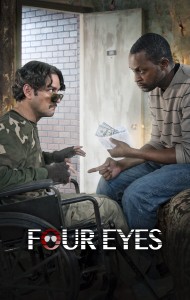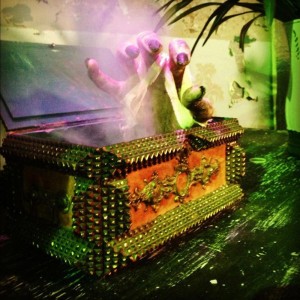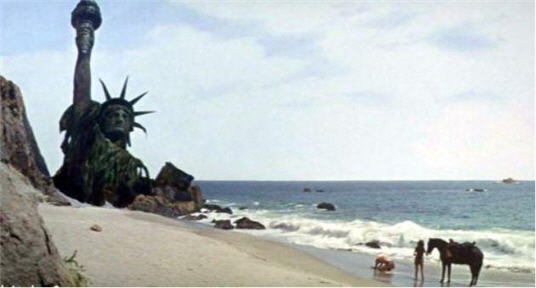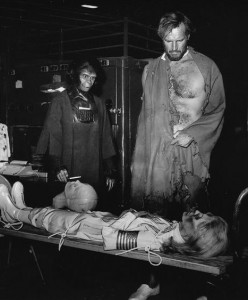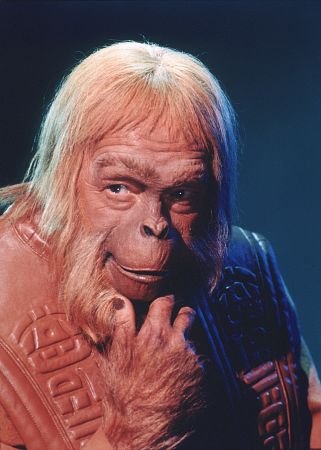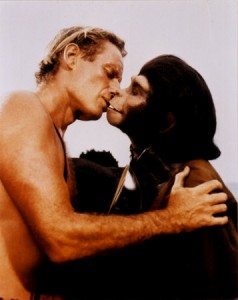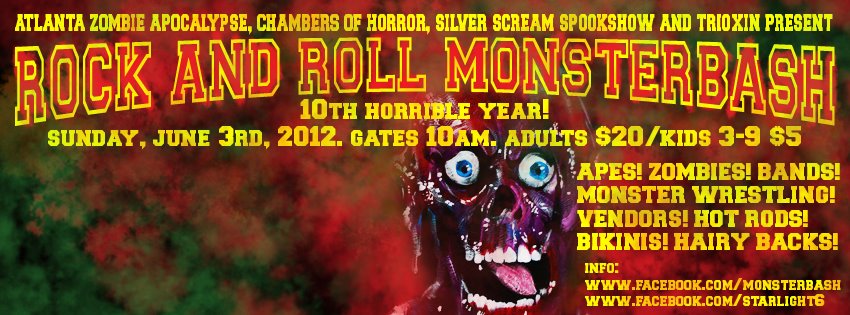by Melanie Crew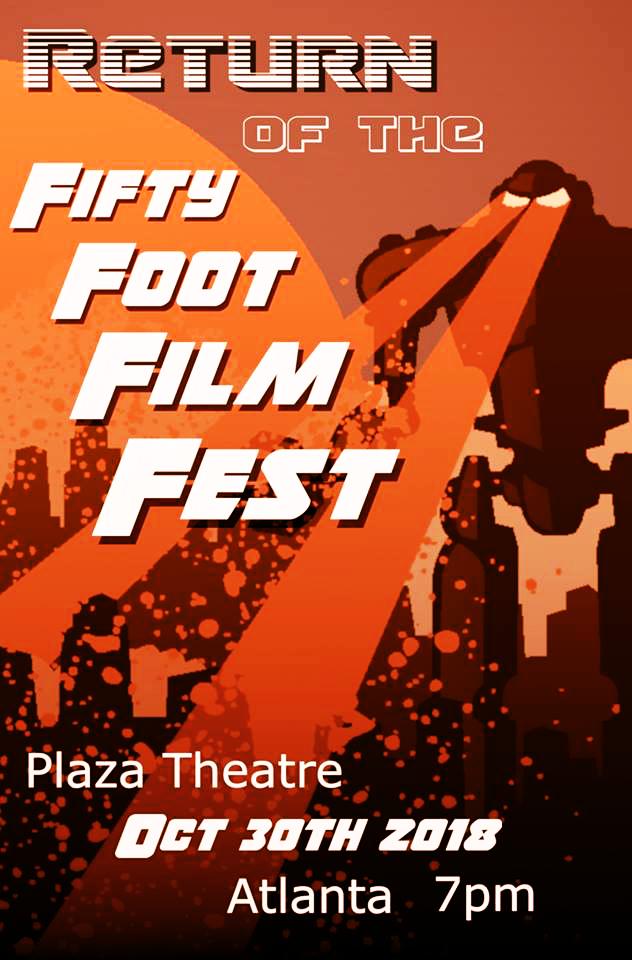
Managing Editor
In this season of ghosts and goblins, Debbie Hess, Executive Producer of the award-winning web anthology series, HORROR HOTEL, where the only recurring character is a menacing dilapidated motor court hotel where “People check in, but they don’t always check out,” along with jack of all film-trades son and Kool Kat Ricky Hess brings Atlanta a special treat (and maybe a few tricks) with the Return of the Fifty Foot Film Festival, invading The Plaza Theater on All Hallows Eve-Eve, October 30, at 7pm!
Return of the Fifty Foot Film Fest gives local sci-fi, horror, suspense and fantasy filmmakers the opportunity to showcase their films at this one-night only event. From premiere screenings to award-winning film shorts, this wee festival delivers a one-stop-shop of terror you won’t want to miss! Last year’s inaugural event, Attack of the Fifty Foot Film Festival, sold out to a hell-raising standing-room-only crowd and featured films by Ricky Hess, Kool Kat Vanessa Ionta Wright (Women in Horror Film Festival) and so many more! This year’s event promises twice as many filmmakers as the previous event, so you’ll definitely want to get your tickets early! Tickets can be purchased here.
ATLRetro caught up with Debbie to chat about the Return of the Fifty Foot Film Fest, the web anthology series HORROR HOTEL, and the importance of local film festivals for indie filmmakers.
ATLRetro: Attack of the 50 Foot Film Festival invades Atlanta for a second exciting year! Can you tell us a little about the event and what inspired you to bring it back to film lovers Atlanta-wide?
 Debbie Hess: We decided to bring the event back for a second year because it was so well received last year and we still saw a need to provide a venue specifically for Atlanta-area filmmakers to raise the awareness of the awesome creative talent we have here. Events like this help to promote content creation and provide a chance for the community to support, encourage and recognize our Georgia films and filmmakers who can get eclipsed by all the media attention and national focus on the larger studio films that are coming here for production. And that is a great thing of course, but we need to constantly be aware that we have content creation going on in our own backyard as well and foster a support system to be able to show these quality films to the community. There’s nothing quite like seeing the film you have so lovingly and laboriously produced shown on the big screen.
Debbie Hess: We decided to bring the event back for a second year because it was so well received last year and we still saw a need to provide a venue specifically for Atlanta-area filmmakers to raise the awareness of the awesome creative talent we have here. Events like this help to promote content creation and provide a chance for the community to support, encourage and recognize our Georgia films and filmmakers who can get eclipsed by all the media attention and national focus on the larger studio films that are coming here for production. And that is a great thing of course, but we need to constantly be aware that we have content creation going on in our own backyard as well and foster a support system to be able to show these quality films to the community. There’s nothing quite like seeing the film you have so lovingly and laboriously produced shown on the big screen.
What makes this event different than other film festivals?
Several things really. First off, it is for Atlanta-area filmmakers only. Most film festivals have entries from all over the world, although many festivals now program sections for local content only, which is good. When you are thrown in with filmmakers from countries that have a lot of grant programs available to make indie films and they are given a lot of money to make a short film, it’s not a level playing field. Most of your local indie filmmakers have similar resource restrictions, which makes it a load more fun to see what everyone has been able to do with that. And with this festival, all the ticket proceeds are split between the filmmakers (whose entry fee is their split of the theatre rental) allowing them more resources to help with their filmmaking. Both last year and this year we have covered the theatre rental fee and had earnings left over to go to our filmmakers. It’s a win-win. Secondly, it’s not a competition festival so there’s no stress involved or disappointment if you don’t win something. Everyone is a winner who has the fortitude to produce a finished film in the first place. It really is more of a celebration of the accomplishments of our local filmmakers right here in our own backyard.
Can you tell our readers what it takes to put on this type of film event?
Sure! It’s quite a bit of work even for a small one like ours. We start out by reaching out to area filmmakers to see if they have a recent film (preferably a premiere) that they would like to submit. I can truly appreciate the dilemma that larger festivals must have in deciding which films to accept. Being a filmmaker myself surely helps because I can judge a little better and appreciate the qualities of an indie film. Some things just don’t require a big budget to get right – a good story, well-written and executed with attention to good filmmaking techniques, along with good editing, good sound, good acting etc. Since this festival is limited to films in the sci-fi, horror, suspense and fantasy genres, we are looking for films that have done a good job creating that “environment” for a visually appealing film in those genres. And then there is the challenge of programming those films in a fixed amount of time and in our case, a short period of time. We would love to have been able to include more of the films that were submitted.
Then there is the promotion work involved to get the word out. Because we want the community to come out and see the films, you have to go as wide as possible to advertise and market that. We post on all the larger and more popular community calendars that are online. We post on all social media and encourage all the filmmakers to do the same. We send out mass emails and loads of press releases and market packages to all the local media including TV stations, radio stations, online publications, student newspapers, podcasts creators, etc. This year we are so grateful to be covered by a number of great media outlets in the Atlanta area that are helping promote the event and the filmmakers. But by far, the filmmakers themselves have the most influence over who comes out to see the films. It’s their invitations to friends, family and people who worked on their film that will garner the most attendees.
 Care to share a little about the films and their directors/creators?
Care to share a little about the films and their directors/creators?
I’d love to since that’s what it’s all about!
THE WISH & THE WISP – Written/Directed by Vashmere Valentine is a delightful fantasy film currently sweeping up awards globally on the festival circuit. It’s about two bickering siblings that learn the true magic of believing when they find a real wish and encounter the menacing creature who wants it back. RESIDENCE 906 (premiere screening) – Directed by Heather Hutton, written by Michele Olson and produced by Iesha Price. Made with over 50 females, this film is a paranormal thriller about the mysterious deaths of a paranormal investigator’s team that force her to confront an enigmatic demon. NO TIME FOR LOVE (premiere screening) – Directed by Ricky Hess. This new episode of HORROR HOTEL is a sci-fi tale about time catching up to a reclusive sailor when a pretty girl brings the modern world into his life. It includes loads of special effects. Fans of The Curious Case of Benjamin Buttons will enjoy this one. FEAST – Written/Directed by Melissa Kunnap is a horror short that recently won best regional film at the Women in Horror Film Festival. The logline reads “A young intern finds out more about his boss and circle of friends than he’d wished to know,” and contains well-done effects. LIVING NIGHTMARE – Created by Jonathan Gabriel and Kristina Miranovic is an anthology of three actual nightmares based on unforgettable accounts, contains very nice sets and effects and is a real skin creep! BAD CANDY – Written/Directed by Scott Hansen is a horror short about a naughty trick R treater which has stunning cinematography and excellent costumes. Creepy clown alert! MR. SMILES (premiere screening) – Written/Directed by Tyler Hunt Weddle is a horror short about a girl who discovers a storybook in an attic whose characters come to life. Goosebump inspired, Freddy Kruger executed. PET’s tagline says it all, “A man with a short fuse and an empty checkbook introduces his irritating boss to man’s best friend,” written/directed by Justin Craig (premiere screening).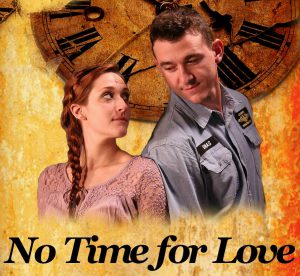
With HORROR HOTEL, you’ve made filmmaking a family affair [you as producer, your son Ricky Hess as the horror anthology’s creator/director and your husband Al Hess as the writer]. Can you tell us a little about the creative process within the family unit and any pros/cons working so closely with your family?
Yes, it has been a family affair and this year we added a new addition to our family, my new daughter-in-law, Allyson Hess, who works on set with us as well. My son Ricky is a powerhouse of talent. He not only is the creator/director but he also does nearly all of the post-production work including editing/color/sound/effects etc. PLUS he is a skilled camera operator as well. My husband, Al, is the writer for the series but he is also a talented props builder, lighting technician, set builder and so much more. Over the years, we have all increased our skill level and learned to do more in other areas which is pretty typical in indie filmmaking. The more you can do yourself, the higher the likelihood you can get something finished. Working within the family has its advantages in that decisions can be made quickly and you have a trusted unit to bounce things off of and get honest feedback on your ideas. There are always differences of opinion in the filmmaking process and you have to work through those sometimes a little more carefully within family, but in the end we all have a deep respect for each other’s opinion and we work it out.
 HORROR HOTEL has become a successful horror anthology, haunting into its 3rd season. What can our readers expect to experience this season, and where can they go to catch new episodes?
HORROR HOTEL has become a successful horror anthology, haunting into its 3rd season. What can our readers expect to experience this season, and where can they go to catch new episodes?
For our upcoming 3rd season, we have made longer films than we normally do, so there will be fewer of them. We tried to up the bar on our production with more challenging episodes that required more effects than we normally have had. Our pilot episode SLEEP TIGHT is about killer bed bugs that invade the hotel rooms. And yes, we did use some real bugs, although they were not bed bugs of course, but we used what is referred to as movie bugs, hissing cockroaches, which are pathogen free and harmless to humans. Nonetheless, quite creepy! It premiered in last year’s festival and got a great response and feedback. It was probably one of the more ‘horror’ episodes we have done as a lot of ours tend to be more sci-fi themed.
The episode we are premiering this year from the 3rd season is sci-fi with loads of special effects and centers on a reclusive sailor (Jason Gaglione) who has shuttered himself away in his hotel room for decades. No one locally has ever seen him. A pretty girl (Kat Rarick) tricks her way into his room and the story is about what happens inside the room after that. We turned the room basically into a time machine. It was extremely challenging and required a ton of SFX make-up, pulled off beautifully by master make-up artists Greg and Sandra Solomon of Etcfx in Newman. If you like stories like THE CURIOUS CASE OF BENJAMIN BUTTON, you will like this episode! Ricky did some exceptional work in post-production as well with some of the visual effects. We had to experiment with quite a few things. So, expect more production value out of 3rd season. It will be releasing later this year or early next year. Currently HORROR HOTEL can be seen on Amazon Prime as an anthology feature film of our 2nd season, Google Play, iTunes, Vudu and select episodes are on DirectTV as well.
What drew you to become a filmmaker and what keeps you playing within the horror genre?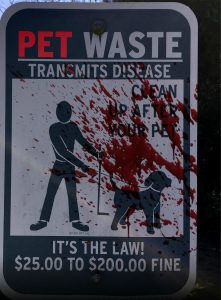
I entered filmmaking by wanting to help Ricky make his HORROR HOTEL series. We had our house used as a set a few years back and we became fascinated with the process and thought it would be great fun to do some ourselves and help him out with that project. Really, the show has more sci-fi stories than mainstream horror. More like THE TWILIGHT ZONE-type of tales, which I love – stories and films that take you to another place and stretch your imagination. I will always tend towards that type of films as favorites.
Is there a film/series you have always wanted to make? Or still plan to make?
We’ve tossed around some ideas for other series but have not nailed anything down. We are just focused at the moment in getting the 3rd season ready to distribute and let the creative juices flow after that!
Smaller local film festivals are all immensely popular these days. How important are these festivals to independent filmmakers? What’s the draw to submit a film and have it screened at one?
It’s much easier to be seen in a smaller local film festival, plus because it is in your community, more people will be able to actually attend and support you. The festivals are vital to indie filmmakers especially those making primarily short films as shorts don’t have much distribution possibility like feature-length films, yet they serve a vital purpose to showcase a filmmakers creative ability as well as those who work on them. Festivals add credibility to a filmmakers resume and at least prove a curator thought highly enough of them to be accepted.
 Who would you say are the filmmakers or films that inspired you the most and what was it about those particular filmmakers/films that inspired you?
Who would you say are the filmmakers or films that inspired you the most and what was it about those particular filmmakers/films that inspired you?
I am a very retro kind of gal and most of my favorite filmmakers are classics like Alfred Hitchcock and Rod Serling. I like the kind of horror/sci-fi they brought to film by creative storytelling and excellent tension building without all the fancy effects. I am a huge fan of most of Hitchcock’s more successful films. No favorite one in particular.
As an independent female filmmaker working in the horror genre, what challenges have you personally faced that seem to be a common theme amongst women in the industry?
I’d say probably just getting taken seriously and being respected. There are a lot of basic female common traits that work for us in filmmaking. Most females tend to be much more organized than our counterparts. I can always count on female cast and crew to be a little more attentive to details, return correspondence quickly and keep their calendar events in check. No male bashing here, just a noted difference in my own experience.
Within the last few weeks comments were made by a well-known production company insisting that he would hire female horror directors if only there were women to be hired. What is your response to this claim? How important do you feel it is to ensure representation exists within the industry, on local and international levels?
Well, the backlash was immense after that came out and they have since apologized, but it obviously was misspoken  as hundreds of people if not thousands of people cited their own female peers as adequately qualified and we know that to be perfectly true just from our own local gals who produce quality work. I think the horror genre was just generally thought to be more male-dominated in the past because of the nature of the content, but festivals like the Women in Horror Film Festival held right here in Georgia certainly proves that to be false.
as hundreds of people if not thousands of people cited their own female peers as adequately qualified and we know that to be perfectly true just from our own local gals who produce quality work. I think the horror genre was just generally thought to be more male-dominated in the past because of the nature of the content, but festivals like the Women in Horror Film Festival held right here in Georgia certainly proves that to be false.
Claims that there aren’t any female horror filmmakers are obviously ludicrous, as Atlanta is chock full of them! Who would you say are your favorite women horror directors and why?
I know of several first-hand that as it happens, have been in our film festival or are this year. Vanessa Ionta Wright, founder of the Women In Horror Film Festival held in Georgia, has done some beautiful and creative films. One was from a Stephen King short story which screened at last year’s festival. And we have not one but two female filmmakers in this year’s fest. Melissa Lee Kunnap has a horror film in there as does Iesha Price. They BOTH contain high quality work. As a matter of fact, Iesha’s film, RESIDENCE 906 was primarily a female production with over 50 women in the cast and crew, only 2 males. That’s impressive to say the least.
Can you give us five things you’re into at the moment that we should be watching, reading or listening to right now— past or present, well-known or obscure?
Watching – Just finished up OZARK on Netflix. Give the series GOLIATH a try on Amazon Prime if you are into Billy Bob Thornton, which I am. I am a huge fan of the FARGO series and the original movie – just plain good storytelling with most excellent creepy characters. I am retro when it comes to music stuff – mostly oldies from the ‘70s. I love reading mystery novels and am constantly burning through books and am currently reading Randy Singer.
 Any advice for up and coming filmmakers out there trying to get their foot in the door?
Any advice for up and coming filmmakers out there trying to get their foot in the door?
Whatever your budget, start with the basics. A good story is first. Get advice on what you have before you film. Don’t get too attached to an idea if it needs to be improved or trashed. Film with the purpose of making it as good as you can possibly get it and employ all the good filmmaking techniques you possibly can. Do your best work always knowing that people will judge you for it. Always be learning and improving your work.
Getting back to what brought us here, Attack of the 50 Foot Film Fest! Anything exciting planned for fest-goers? With this being the second exciting year, can we expect this to be an annual event, something we all can look forward to in years to come?
We will be talking briefly after the screening to the filmmakers and I think a few of them will have some exciting announcements about upcoming projects they will share. Annual event? We will see. We take that one year at a time and see if there is interest among the local filmmakers to make it happen!
Photos courtesy of Debbie Hess and used with permission.

